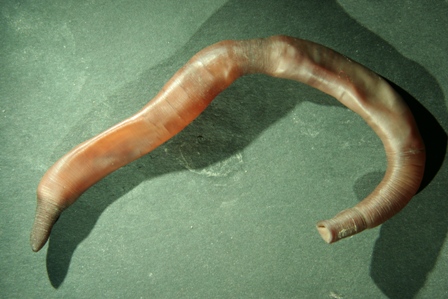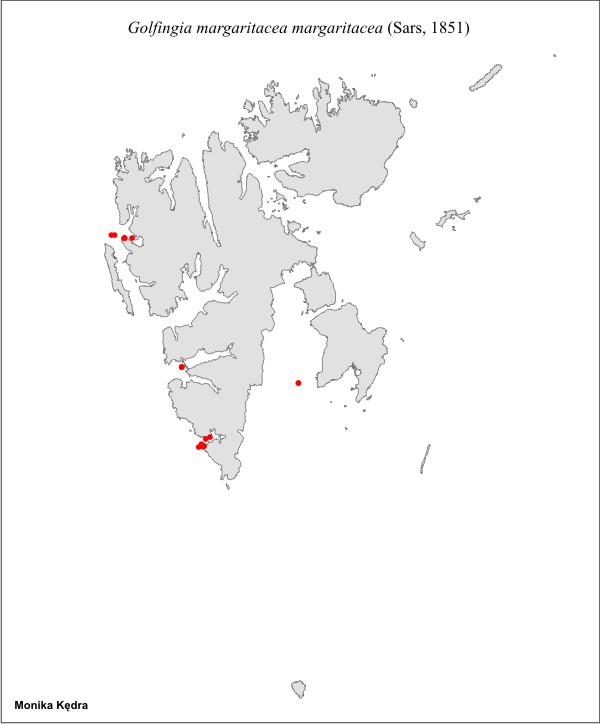Golfingia margaritacea margaritacea (Sars, 1851)
A common cosmopolitan species dwelling in mud and sand/gravel bottoms

Golfingia margaritacea |

Golfingia margaritacea internal view |

|
Sipunculus margaritaceus Sars, 1851
Phascolosoma margaritaceum Danielssen and Koren, 1877
Distinguishing characteristics
Four retractor muscles present.
Hooks absent.
Many cuticular bodies and papillae on the skin. The latter are the most distinct on the posterior end of the trunk.
Up to 24 slender, flattened tentacles, but most specimens have only 8 to 16 arranged in a single circle around the mouth.
Species with wide morphological variability, especially in case of large specimens showing the greatest morphological variations, especially in the appearance and structure of the skin.
Size
Juvenile: total length of 6 mm
Common trunk length: 10-30 mm
Maximum trunk length: up to 150 mm
Color
From light to medium brown
Habitat
Inhabits sand and mud
Feeding
Deposit feeder
Life cycle
Probably trochophore larva
More Biology & Ecology
Golfingia margaritacea, found in very high numbers and significant biomass, may be an important food source for higher trophic levels fauna in Svalbard fjords. This species is an important part of the diet of the fish (Gadiformes, Scorpaeniformes, Pleuronectiformes) as well as of several sea stars and some gastropods in the Barents Sea, Greenland Sea and Alaska.
Distribution
Very widely distributed; known from depths of 1-5300 m, but mainly from depths less than 300 m. Found in all sectors of the Atlantic, Antarctic and Arctic oceans.
References
- Cutler EB (1977) Scientific results of the Danish Deep-Sea Expedition round the world 1950-52. Galathea Report 14:135-157
- Cutler EB (1994) The Sipuncula. Their Systematics, Biology, and Evolution. 1-453
- Cutler EB, Murina VV (1977) On the sipunculan genus Golfingia Lankester, 1885. Zoological Journal of the Linnaean Society 60:173-187
- Fischer W (1896) Gephyreen der Hamburger Magalhaensischen Sammelreise.
- Fischer W (1914) Wietere Mitteilungen uber die Gephyreen des Naturhistorischen (Zoologischen) Museums zu Hamburg. Jahrbuch der Hamburgischen Wissenschaftlichen Anstalten 31:1-28
- Fischer W (1922) Gephyreen der Arkischen Meere. Wissenschaftliche Meeresuntersuchungen Abteilung Helgoland 13:229-246
- Fischer W (1929) Die Sipunculiden, Priapuliden und Echiuren der Arktis. 5
- Gerould JH (1913) The sipunculids of the eastern coast of North America. Proceedings of the United States National Museum 44:373-437
- Gibbs PE (1973) On the genus Golfingia (Sipuncula) in the Plymouth area with a description of a new species. Journal of the Marine Biological Association of the United Kingdom 53:73-86
- Gibbs PE (1974) Golfingia margaritacea (Sipuncula) in British waters. Journal of the Marine Biological Association of the United Kingdom 54:871-877
- Gibbs PE (2001) Sipunculans. Key and Notes for the Identification of British Species, Synopses of the British Fauna (New Series). Crothers J.H.// Hayward P.J.
- Gibbs PE, Cutler EB (1987) A classification of phylum Sipuncula. Bulletin of the British Museum Natural History Zoology 52:43-58
- Kędra M, Murina GV (2007) The sipunculan fauna of Svalbard. Polar Research 26:37-47
- Kędra M, Wćodarska-Kowalczuk M (2008) Distribution and diversity of sipunculan fauna in high Arctic fjords (west Spitsbergen). Polar Biology 31:1181-1190
- Murina GV (1977) Marine worms of the Arctic and boreal waters of Europe. Identification books of the USSR fauna.
- Pancucci-Papadopoulou MA, Murina GV, Zenetos A (1999) The phylum Sipuncula in the Mediteranean Sea. 1-109
- Théel H (1875) Etudes sur des Gephyreens inermes des ers de la Scandinavie, du Spitsberg et du Groenland. Kungliga Svenska Vetenskaps-Akademies Handlingar 3:1-30
- Théel H (1905) Northern and arctic invertebrates in the collection of the Swedish State Museum. I. Sipunculids. Kungliga Svenska Vetenskaps-Akademies Handlingar 3:1-30
- Wesenberg-Lund E (1925) Gephyreer. Conspectus Faunae Groenlandicae. Meddelelser om Grřnland 23:81-91
- Wesenberg-Lund E (1930) Priapulida and Sipunculidae. Danish Ingolf-Expedition 4:1-44
- Wesenberg-Lund E (1933) The collections of Gephyreans in the Royal Museum of Natural History of Belgium. Bulletin du Institute Royal des Sciences Naturelles de Belgique 9:1-15
- Wesenberg-Lund E (1937a) Gephyrea :The zoology of Iceland. 2:1-17
- Wesenberg-Lund E (1937b) The zoology of east Greenland: Gephyreans. Meddelelser om Gronland 121:1-25
- Wesenberg-Lund E (1938a) Norwegian Gephyrea from the collections of the Zoological Museum of Trondheim. Det Kongelige Norske Videnskabers Selskabs Forhandlinger 11:26-29
- Wesenberg-Lund E (1938b) The Godthaab Expedition 1928. Gephyrea. Meddelelser om Gronland 79:1-29
- Wesenberg-Lund E (1939) Gephyreans from Swedish waters in the Museum of Natural History of Gothenburg. Göteborgs Kungliga Vetenskaps Vittenhets-Samhälles Handlingar 6:1-35
- Wesenberg-Lund E (1954) Priapuloidea, Sipunculoidea and Echiuroidea. Bulletin du Institute Royal des Sciences Naturelles de Belgique 30:1-18
